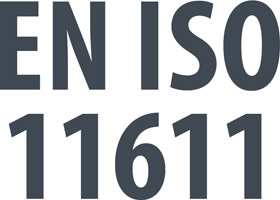

In order to comply with EN ISO 11611 all external pockets must be flapped, except for side pockets below the waist which do not extend more than ten degrees forward of the seam.
A single rule pocket with an opening not greater than 75mm is permitted behind the side seam on one or both legs.


To meet EN ISO 11611 tensile strength must be at least 400N and tear strength must be at least 15N for class 1 and 20N for class 2.
For example:
Portwest's winning FR50 style has a tensile strength value of at least 500N and tear strength of at least 25N after 50 washes.


Reflective tape must be at least 50mm wide. Bands of reflective tape must be positioned at least 50mm apart.
Reflective tape must be positioned 50mm or more from the end of sleeve or leg.

Reflective tape must encircle torso and/or limbs to be included in the calculation of the necessary square area of reflective tape. A gap (for fastening system or seam) in the band of reflective tape must be 50mm or less. The total amount of such gaps in every band must not exceed 100mm around the torso and 50mm around the sleeves and legs.

Highest level of protection - required for any persons working on or near motorways, dual-carriage ways or airports. Must incorporate a minimum of 0.80m2 of background material and 0.20m2 of retroreflective materials. (4 metres of 5cm wide reflective tape)

Required for any persons working on or near A and B class roads, also for delivery drivers. Must incorporate a minimum of 0.50m2 of background material and 0.13m2 of retro-reflective material. (2.60 metres of 5cm wide reflective tape)

Minimum level of protection required for any persons working on a private road or to be used in conjunction with a higher classed garment. Must incorporate a minimum of 0.14m2 of background material and 0.10m2 of retroreflective material. (2 metres of 5cm wide reflective tape)


This international standard specifies minimum basic safety requirements and test methods for protective clothing for use in welding and allied processes (excluding hand protection). There are two classes with specific performance requirements.


Class 1 is protection against less hazardous welding techniques and situations, causing lower levels of spatter and radiant heat.
Class 2 is protection against more hazardous welding techniques and situations, causing higher levels of spatter and radiant heat.

The EN ISO 11611: standard has the following parameters:


This European standard is part of a series of standards for test methods and requirements for electrostatic properties of protective clothing.
The standard specifies material and design requirements for garments used as part of a total earthed system, to avoid incendiary discharges.
The requirements may not be sufficient in oxygen enriched flammable atmospheres.
This European Standard is not applicable for specifying protection against main voltages.


Test method for measurement of surface resistivity. Surface resistance measures the conductivity between two points on the surface of a fabric. The lower the resistance the higher the conductivity, resulting in charge going to earth.
Test method for measurement of the electrical resistance through a material (vertical resistance). This is the level of conductivity when measured through the depth of a fabric.


Test methods for measurement of charge decay. Charge decay measures how long it takes for an electric current to dissipate. The quicker it dissipates the higher the anti-static properties of the garment.
Please note the EN 1149-4 Garment Test is under development.
EN 1149-5 specifies the performance and design requirements to avoid static discharge for all electrostatic dissipative protective clothing as part of an entire earthed system, shoes, clothing & floor. The material meets the requirements.

EN ISO 11612 is the standard for protective clothing which protects against heat and flame. Users for these garments include those who work in oil & gas, welding & allied processes, mining, petroleum and many other industries.
There are a host of specific tests conducted as part of EN ISO 11612, including tests for: Flame Spread, Tensile Strength, Tear Resistance, and Heat Resistance.


Flame Spread Test:
A flame is held against the fabric for ten seconds. After it is removed the fabric should not continue to burn. There should be no hole formation, melting or molten debris.
Tensile Strength Test:
The fabric must be able to withstand a minimum force of 300 newtons while being stretched or grabbed.


Tear Resistance Test:
The fabric must be able to withstand a minimum force of 10 newtons before it will tear.
Heat Resistance Test:
The fabric is placed in an oven at 180oC and must not ignite melt or shrink within the first 5 minutes in order to comply with the standard.

This standard investigates the fabric and garment's ability to protect against the thermal effects of an electric arc. This can be done via two test methods: 1. IEC 61482-1-1 (Open Arc Test Method) and 2. IEC 61482-1-2 (Box Test Method).
An electric arc is an intense flash of electricity which can result in numerous injuries.
Garments can be layered to achieve a better Cal rating. For example, a thermal layer may achieve an Ebt of 4.3 Cal/cm2, and an outer coverall may achieve an ATPV of 13.6 Cal/cm2. However, the combination ATPV/Ebt ratings will be greater than the sum of the two single layers, as the air gap between the two layers affords the wearer additional protection.

This test method aims to establish an ELIM (Incident Energy Limit) and an ATPV rating of a fabric and/or garment. These values, expresses as cal/cm², are the highest incident thermal energy to which the garment can be exposed without the wearer getting a second degree burn or the formation of holes in the fabric. The higher the cal rating of the garment or fabric, then the greater the protection for the wearer.

This test method aims to establish an APC1 or an APC2 rating of a fabric and/or garment (APC=Arc Protection Class). Test conditions for APC1 & APC2 try to simulate typical exposure conditions for a short circuit current of 4kA and 7kA respectively.
A single layer garment in most cases will pass APC1. For APC2, a thicker fabric or multi layer system is required.

Garments must be laundered according to the manufacturer's instructions; incorrect laundering of flame resistant garments can seriously affect their performance and fit.
The flame resistant finish is retained for the normal life cycle of the garment provided that the care instructions are adhered to.



Introducing the Portwest FR Hi-Vis Long Sleeve T-Shirt - Yellow: A blend of unmatched safety and top-tier comfort. Designed with a unique interlock knit fabric, this t-shirt is light on weight yet heavy on insulation. Tailored for diverse industrial environments, it offers the dual advantage of hi-vis capabilities and unyielding flame resistance.
Key Features:
Standards:
With the Portwest FR Hi-Vis Long Sleeve T-Shirt - Yellow, you're not just wearing a t-shirt; you're wearing a promise of safety, comfort, and style. Dive into the world where advanced protection meets modern design.
Introducing the Portwest FR Hi-Vis Long Sleeve T-Shirt - Yellow: A blend of unmatched safety and top-tier comfort. Designed with a unique interlock knit fabric, this t-shirt is light on weight yet heavy on insulation. Tailored for diverse industrial environments, it offers the dual advantage of hi-vis capabilities and unyielding flame resistance.
Key Features:
Standards:
With the Portwest FR Hi-Vis Long Sleeve T-Shirt - Yellow, you're not just wearing a t-shirt; you're wearing a promise of safety, comfort, and style. Dive into the world where advanced protection meets modern design.
Introducing the Portwest FR Hi-Vis Long Sleeve T-Shirt - Yellow: A blend of unmatched safety and top-tier comfort. Designed with a unique interlock knit fabric, this t-shirt is light on weight yet heavy on insulation. Tailored for diverse industrial environments, it offers the dual advantage of hi-vis capabilities and unyielding flame resistance.
Key Features:
Standards:
With the Portwest FR Hi-Vis Long Sleeve T-Shirt - Yellow, you're not just wearing a t-shirt; you're wearing a promise of safety, comfort, and style. Dive into the world where advanced protection meets modern design.
Introducing the Portwest FR Hi-Vis Long Sleeve T-Shirt - Yellow: A blend of unmatched safety and top-tier comfort. Designed with a unique interlock knit fabric, this t-shirt is light on weight yet heavy on insulation. Tailored for diverse industrial environments, it offers the dual advantage of hi-vis capabilities and unyielding flame resistance.
Key Features:
Standards:
With the Portwest FR Hi-Vis Long Sleeve T-Shirt - Yellow, you're not just wearing a t-shirt; you're wearing a promise of safety, comfort, and style. Dive into the world where advanced protection meets modern design.
Introducing the Portwest FR Hi-Vis Long Sleeve T-Shirt - Yellow: A blend of unmatched safety and top-tier comfort. Designed with a unique interlock knit fabric, this t-shirt is light on weight yet heavy on insulation. Tailored for diverse industrial environments, it offers the dual advantage of hi-vis capabilities and unyielding flame resistance.
Key Features:
Standards:
With the Portwest FR Hi-Vis Long Sleeve T-Shirt - Yellow, you're not just wearing a t-shirt; you're wearing a promise of safety, comfort, and style. Dive into the world where advanced protection meets modern design.
Introducing the Portwest FR Hi-Vis Long Sleeve T-Shirt - Yellow: A blend of unmatched safety and top-tier comfort. Designed with a unique interlock knit fabric, this t-shirt is light on weight yet heavy on insulation. Tailored for diverse industrial environments, it offers the dual advantage of hi-vis capabilities and unyielding flame resistance.
Key Features:
Standards:
With the Portwest FR Hi-Vis Long Sleeve T-Shirt - Yellow, you're not just wearing a t-shirt; you're wearing a promise of safety, comfort, and style. Dive into the world where advanced protection meets modern design.
Introducing the Portwest FR Hi-Vis Long Sleeve T-Shirt - Yellow: A blend of unmatched safety and top-tier comfort. Designed with a unique interlock knit fabric, this t-shirt is light on weight yet heavy on insulation. Tailored for diverse industrial environments, it offers the dual advantage of hi-vis capabilities and unyielding flame resistance.
Key Features:
Standards:
With the Portwest FR Hi-Vis Long Sleeve T-Shirt - Yellow, you're not just wearing a t-shirt; you're wearing a promise of safety, comfort, and style. Dive into the world where advanced protection meets modern design.
Specifications are subject to change - See Terms & Conditions for more info
Portwest has been independently rated by Ecovadis for its environmental, social, and ethical performance and achieved a silver rating, meaning they are in the top 25% of globally rated companies.
The pillars taken into consideration include the environment, labour practices and human rights, ethics, and sustainable procurement.
This product conforms with essential health and safety requirements as set out in European Directives.
This product is CE marked as a Category 3 item for complex design.
40+ UPF rated fabric to block 98% of UV rays.
Wash at a Maximum Temperature of 40°C using a delicate wash cycle
Do not bleach this item
This item must not be tumbled dried
This item must be line dried
This item can be ironed on a medium temperature setting of up to 150°C
Do not dry clean this item